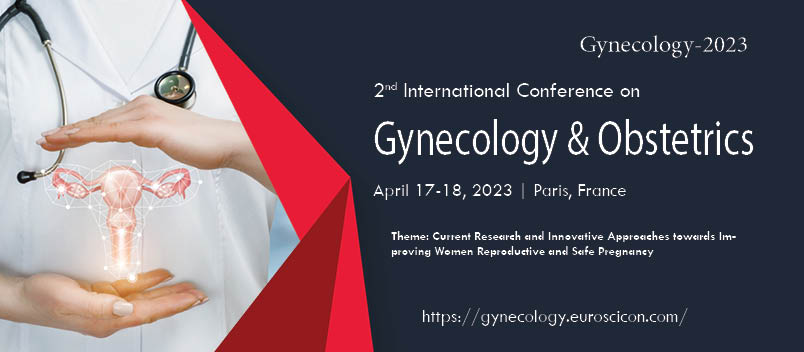GYNECOLOGY-2023
ABOUT CONFERENCE
The Organizing Committee of the “2nd International Conference on Gynecology & Obstetrics" invites you to participate in the congress which will be held from February 22-23, 2023 which includes Prompt Keynote presentations, Oral, Poster Presentations and Exhibitions. The conference aims to foster and conduct collaborative interdisciplinary research in state-of-the-art methodologies and cutting edge technologies in Gynecology and Obstetrics through its invited presentation, submitted oral and poster abstracts the conference program focuses on theme “Current Research and Innovative Approaches towards Improving Women Reproductive Health”.
Euroscicon Professional Conference Organizer organizes 1000+ Conferences every year across USA, Europe & Asia with support from 1000+ more scientific societies and Publishes 700+ Open access journals which contains over 100,000 eminent personalities, reputed scientists as editorial board members.
Gynecology-2023 offers a cutting edge program of Renowned International Speakers, attracting over 300+ experts in fertility, Assisted conception, Sexual health and Reproductive biology. This conference intends to gather all the people across the globe like Students, Lecturers, Assistant Professors, Professors, Directors, Chairman, Chancellor, Scientists, Doctors, Managing Directors, Chief Executive Officers, Presidents and Noble Laureates and base a platform for them to share their experience, knowledge and research work, recent advancements in the field of Women’s Health. In addition to cutting-edge presentations and debates, this year agenda provides you with an opportunity to participate in or organize a Workshop.
Why to attend?
With members from around the world focused on learning about Women’s Health and its advances; this is your best opportunity to reach the largest assemblage of participants from the Women’s Health community. World-renowned speakers, the most recent techniques, developments, and the newest updates in women’s health, breast cancer, gynecological issues, pregnancy, Woman Psychology, women disorders are hallmarks of this conference.
Opportunity to attend the presentations delivered by Eminent Scientists from all over the world
Accepted abstracts will be published in Journal of Nursing and Healthcare and provided with DOI
Discuss your ideas and views with pioneers in the fields of Gynecology, Obstetrics, Midwifery and Fertility
Be a part of the interactive debates, plenary sessions and discussions about the current issues in the area of Women’s health and come to a consensus using evidence-based expert opinion
Target Audience:
- Scientists and professors
- Gynecology Surgeons
- Women’s health Care Researchers
- Healthcare Faculty
- Registered Nurse
- Medical Colleges Staff
- Healthcare Associations and Societies
- Business Entrepreneurs
- Midwife Nurse Educator
- Nurse Practitioner
- Gynecologists
- Obstetricians
- Infertility Specialists
- Gynecological Pathologists
- Embryologists
- Radiographers and Sonographer
- Anesthesiologist
Sessions & Tracks
Track 1: Gynecology and Obstetrics
An obstetrician-gynaecologist, or OB-GYN, is endured in womanish reproductive health, gestation and parturition.. Others concentrated on the medical care of the womanish reproductive system. Midwives also give routine medical services and preventative examinations. This type of croaker studied obstetrics and gynecology. A branch of drug specializing in the care of women during gestation and parturition and in the opinion and treatment of conditions of the womanish reproductive organs. She also specializes in other women's health issues, similar as menopause, hormonal issues, contraception, and gravidity.
Track 2: Pregnancy Trimesters
Trimester In obstetrics, one of these three divisions of three months each during pregnancy in which different phases of fetal development take place. The first trimester is a time of introductory cell isolation. The alternate trimester is a period of rapid-fire growth and development of body systems. A alternate-trimester fetus that's born precociously may be feasible, given the stylish sanitarium care possible. The third trimester makes the final stage of fetal growth, in which systems are completed fat accumulates under the soon-to-be-born baby's skin, and the fetus at last moves into position for birth. This trimester ends with birth.
Track 3: Reproductive endocrinology
Reproductive endocrinology and infertility (REI) is a surgical subspecialty of obstetrics and gynecology that trains physicians in reproductive medicine addressing hormonal functioning as it pertains to reproduction as well as the issue of infertility. It has specialty training in obstetrics and gynecology (ob-gyn) before they undergo sub-specialty training (fellowship) in REI. Reproductive surgery is a related specialty, where a physician in ob-gyn or urology further specializes to operate on anatomical disorders that affect fertility
Track 4: Placenta and Membrane
The placental membrane separates maternal blood from fetal blood. The maternal component of the placenta is known as the decidua basalis. Oxygen and nutrients in the maternal blood in the intervillous spaces diffuse through the walls of the villi and enter the fetal capillaries. The two chorioamniotic membranes are the amnion and the chorionic, which make up the amniotic sac that surrounds and protects the fetus. The placenta functions as a fetomaternal organ with two components: the fetal placenta (Chorion frondosum), which develops from the same blastocyst that forms the fetus, and the maternal placenta (Decidua basalis), which develops from the Chorion refers to the outermost membrane surrounding an embryo of a reptile, bird, or mammal while placenta refers to a temporary organ that connects the developing fetus via the umbilical cord to the uterine wall in placental mammals. Thus, this explains the main difference between chorion and placenta maternal uterine tissue.
Track 5: Infertility and Genetics
Genetics of infertility. About 10–15% of human couples are infertile, unable to conceive. In approximately in half of these cases, the underlying cause is related to the male. Genetic factors including aneuploidies and single-gene mutations are also contributed to the male infertility. Infertility is common. Out of 100 couples in the United States, about 12 to 13 of them have trouble becoming pregnant. About one-third of infertility cases are caused by fertility problems in women, and another one-third of fertility problems are due to fertility problems in men.
Track 6: Obstetrical Complications
Obstetric complications refer to disruptions and disorders of pregnancy, labour and delivery, and the early neonatal period. Examples of such complications include prenatal drug exposure, poor maternal nutrition, minor physical anomalies (or MPAs: indicators of fetal neural maldevelopment, occurring near the end of the first trimester), and birth complications. Obstetric complications can have long-term effects on a child, including an increase in problematic behaviour. Research has identified links between obstetric complications and subsequent human aggression, and suggests that obstetric complications may elicit aggression by affecting brain development.
Track 7: Gynecologic Surgery
Gynaecologic surgery is surgery on any part of a woman’s reproductive system, including the vagina, cervix, uterus, fallopian tubes, and ovaries. Gynaecologic surgeons often do procedures on a woman’s urinary tract as well, including the bladder. Some gynaecologic surgeries are simple and may be done in at the gynaecologist’s office, while others are done in the hospital. Common gynaecologic surgeries include Tubal ligation (tubes tied)Removal of ovarian cysts (non-cancerous growths on an ovary)Removal of cysts or fibroids (non-cancerous growths) in the uterus Removal of growths from the cervix (the lower part of the uterus that connects to the vagina)Uterine artery embolization, which cuts off the blood supply to a uterine fibroid so it gets smaller Removal of the uterus (hysterectomy), ovaries, or other parts of a woman’s reproductive system Surgical treatment of gynecological (cervical, uterine, and ovarian) cancers Cystoscopy, which is a procedure that lets the doctor look inside the urinary tract to check for growths, bladder stones, or other problems Hysteroscopy, which is a procedure that lets the doctor look inside the uterus by inserting a thin tube through the vagina and cervix.
Track 8: Female Pelvic and Reconstructive Surgery
Female Pelvic Medicine and Reconstructive Surgery focuses on the surgical and non-surgical treatment of pelvic floor disorders, which include pelvic organ prolapse, incontinence, and pelvic pain. Reconstructive surgery is used to restore the organs of the pelvic floor to their normal position. The surgery used for this condition is a robotic assisted sacrocolpopexy. Pelvic floor reconstruction is a group of surgical procedures used to treat pelvic organ prolapse, a condition that occurs when the muscles of the pelvic floor are weakened or damaged, often due to childbirth. Other causes include repeated heavy lifting, chronic disease, or surgery. Most patients require at least some prescription strength pain medicine for about one to two weeks after surgery. After any surgery to correct urinary incontinence or prolapse, we ask that patients “take it easy” usually for 12 weeks to allow proper healing.
Track 9: Gynecologic Oncology
Oncology is the study of cancer. An oncologist is a doctor who treats cancer and provides medical care for a person diagnosed with cancer. The field of oncology has three major areas: medical, surgical, and radiation. A medical oncologist treats cancer using chemotherapy or other medications, such as targeted therapy or immunotherapy. A surgical oncologist removes the tumor and nearby tissue during surgery. He or she also performs certain types of biopsies to help diagnose cancer. A radiation oncologist treats cancer using radiation therapy. Other types of oncologists include: A gynecologic oncologist treats gynecologic cancers, such as uterine, ovarian, and cervical cancers. A pediatric oncologist treats cancer in children. Some types of cancer occur most often in children and teenagers. This includes certain brain tumors, leukemia, osteosarcoma, and Ewing’s sarcoma. Types of cancer more common in children sometimes also occur in adults. In these situations, an adult may decide to work with a pediatric oncologist. A hematologist-oncologist diagnoses and treats blood cancers, such as leukemia, lymphoma, and myeloma.
Effects of Drugs on Pregnancy: Some medications can adversely affect a fetus, but in some cases the benefits outweigh the risks. Diabetes mellitus during pregnancy may need intensive therapy with insulin to prevent complications to mother and baby. Pain management for the mother is an important area where an evaluation of the benefits and risks is needed. NSAIDs such as ibuprofen and naproxen are probably safe for use for a short period of time, 48–72 hours, once the mother has reached the second trimester. If taking aspirin for pain management the mother should not take a dose higher than 100 mg.
Track 10: Abortion
Abortion is the ending of a pregnancy by removal or expulsion of an embryo or fetus before it can survive outside the uterus. An abortion that occurs without intervention is known as a miscarriage or spontaneous abortion. When deliberate steps are taken to end a pregnancy, it is called an induced abortion, or less frequently "induced miscarriage". The unmodified word abortion generally refers to an induced abortion. A similar procedure after the fetus has potential to survive outside the womb is known as a "late termination of pregnancy" or less accurately as a "late term abortion".
Track 11: Urogynecology
Urogynecology is a subspecialty of Gynecology that focuses on the combination of women’s health and urology. They treat a range of conditions that involve the pelvic organs that are part of the urinary or reproductive system. An OB/GYN in general practice can provide urogynecology services to their patients in many instances. In more complex cases a urogynecologist is needed, especially when surgery is recommended. A urogynecologist is a doctor who has completed training in both Gynecology and urology.
Urinary incontinence is a condition in which someone loses control of their bladder. It can be mild and only cause occasional leaking. More severe cases may cause urinary urgency so sudden that the person does not make it to the toilet in time.
Track 12: Radiography
Radiography is an imaging technique using X-rays, gamma rays, or similar ionizing radiation and non-ionizing radiation to view the internal form of an object. Applications of radiography include medical radiography ("diagnostic" and "therapeutic") and industrial radiography
Track 13: Projectional radiography
The creation of images by exposing an object to X-rays or other high-energy forms of electromagnetic radiation and capturing the resulting remnant beam (or "shadow") as a latent image is known as "projection radiography." The "shadow" may be converted to light using a fluorescent screen, which is then captured on photographic film, it may be captured by a phosphor screen to be "read" later by a laser (CR), or it may directly activate a matrix of solid-state detectors (DR—similar to a very large version of a CCD in a digital camera). Bone and some organs (such as lungs) especially lend themselves to projection radiography. It is a relatively low-cost investigation with a high diagnostic yield. The difference between soft and hard body parts stems mostly from the fact that carbon has a very low X-ray cross section compared to calcium.
Track 14: Computed tomography
Computed tomography or CT scan (previously known as CAT scan, the "A" standing for "axial") uses ionizing radiation (x-ray radiation) in conjunction with a computer to create images of both soft and hard tissues. These images look as though the patient was sliced like bread (thus, "tomography"-- "tomo" means "slice"). Though CT uses a higher amount of ionizing x-radiation than diagnostic x-rays (both utilizing X-ray radiation), with advances in technology, levels of CT radiation dose and scan times have reduced. CT exams are generally short, most lasting only as long as a breath-hold, Contrast agents are also often used, depending on the tissues needing to be seen. Radiographers perform these examinations, sometimes in conjunction with a radiologist (for instance, when a radiologist performs a CT-guided biopsy).
Track 15: Cosmetic Gynecology
Cosmetic Gynecology has become one of the fastest growing subspecialties of elective surgery for women and includes specialists in gynecology, urogynecology, urology, and plastic surgery. This area of special interest includes both cosmetic procedures to enhance the aesthetic appearance of the vulvo/vaginal region, as well as functional vaginal repairs to enhance or help restore sexual function following the changes that may occur following childbirth and/or aging. Female genital cosmetic surgery also includes aesthetic procedures to improve the cosmetic appearance of the external vulvar/vaginal region. Procedures include labiaplasty or labia minora reduction with or without excess prepuce reduction, labia majora reduction or augmentation, vaginal introital repairs for cosmetic issues as well as reduction of lipodystrophy in the mons pubis region. Recently, new technology has been introduced in the field offering non-surgical/office based procedures to treat female sexual dysfunction (VLS), vaginal health and vulvo/vaginal cosmetic issues for women. This technology includes non-fractional lasers as well as radiofrequency treatments. Scientific studies are currently evaluating this technology for these uses as well as treatment for mild urinary incontinence, urgency/frequency issues as well as vaginal dryness.
Track 16: Hepatitis In Pregnancy
Hepatitis is a type of infection that can seriously damage your liver. And if you’re pregnant, you can pass it on to your newborn. You can have one of the three most common types of hepatitis viruses -- A, B, and C -- and not know it. Usually, it won’t hurt your unborn baby or affect your pregnancy. If your doctor knows you have it, or might have it, she can help you manage it during your pregnancy to lower the chances of any long-term liver disease for you and your baby.
Labor: Childbirth, the process of delivering a baby and the placenta, membranes, and umbilical cord from the uterus to the vagina to the outside world. During the first stage of labor (which is called dilation), the cervix dilates fully to a diameter of about 10 cm (2 inches). The first stage of labor is divided into two phases: the latent phase and the active phase. In the latent phase, contractions become progressively more coordinated and the cervix dilates to 4 cm (approximately 1.5 inches). The latent phase averages about 8 hours for a nullipara (a woman having her first baby) and 5 hours for a multipara (a woman having a subsequent baby). In the active phase, the cervix becomes fully dilated and the presenting part of the baby descends into the mid pelvis. The active phase averages about 5 hours for a nullipara and 2 hours for a multipara. In the second stage (which is called expulsion), the baby moves out through the cervix and vagina to be born. Expulsion generally lasts 2 hours for a nullipara and l hour for a multipara. The third stage of labor begins with the delivery of the baby and ends when the placenta and membranes are expelled also known as parturition and childbirth.
Track 17: Reproductive system Disorders
Reproductive disorders are diseases involving the reproductive system, including reproductive tract infections, congenital abnormalities, cancers of the reproductive system and sexual dysfunction. Reproductive system disease, any of the diseases and disorders that affect the human reproductive system. They include abnormal hormone production by the ovaries or the testes or by other endocrine glands, such as the pituitary, thyroid, or adrenals. Such diseases can also be caused by genetic or congenital abnormalities, infections, tumours, or disorders of unknown cause.
The main divisions of this article are concerned with (1) genetic and congenital abnormalities, (2) functional genital disorders, (3) infections, (4) structural changes of unknown cause, and (5) tumors. For discussion of diseases and disorders affecting pregnancy, see pregnancy. For diseases and disorders affecting childbirth, see parturition. Hormonal disorders affecting reproductive organs and functions are also discussed in the article human endocrine system. Infectious diseases covered in this chapter include syphilis, herpes simplex virus (HSV), chancroid, lymph granuloma venereum (LGV), human papillomavirus infection (HPV), and Chlamydia/gonorrhea. Syphilis is a sexually transmitted disease caused by the spirochete Treponema pallidum. Sexually transmitted diseases, such as gonorrhea and chlamydia, are typical causes of pelvic inflammatory disease, according to the NIH. "Any of these STIs can cause serious and potentially long term reproductive problems that include chronic pelvic pain and infertility,"
Erectile dysfunction, premature ejaculation, loss of libido, testicular cancer and prostate disease may cause embarrassment to the patient and, occasionally, the general practitioner. We describe how patients affected by these conditions may present to general practice, and discuss the reasons why they may not present.
Track 18: Gynecologic Cancers: Case Report
There we kept two case report of gynaecology cancer, 1) 80-year-old female was diagnosed with ovarian cancer in March 2004. Following gynecological surgery, pathological evaluation showed stage IIIC epithelial ovarian cancer. From March 2004 to January 2005, the patient received six cycles of conventional treatment combined with intravenous paclitaxel (Taxol®) and cisplatin. The patient developed abdominal distension and experienced a gradual deterioration in health during 2007, with admission to The First Affiliated Hospital in May 2007. 2) 53-year-old woman comes in for her first visit. She is an immigrant from South Africa who has lived in the United States for 6 years and has not had regular health care. Her past medical history is notable for hypertension and osteoarthritis. She takes no medications. She is married with six children; her husband is a long-haul truck driver. Her first sexual contact was at age 15, and she has had five partners in her lifetime. She has been smoking one pack of cigarettes per day for the last 31 years. She reports vaginal spotting after intercourse, which she thinks is related to vaginal dryness after menopause.
Track 19: Male Reproductive Cancers:
Prostate cancer is the most common male cancer in the UK, accounting for 25% of all new male cancers. Age related, the incidence rises sharply from 50 years of age with the highest incidence in those 75-80 years and higher incidence in men of Afro-Caribbean descent. If a tumour starts to develop on active surveillance or is thought to be intermediate/high risk localised disease, surgical removal of the prostate may be advised. Surgery is the main treatment for penile cancer where the tumours are very small this may be laser surgery or cryosurgery. Global revenues for the urological cancer market are forecast to grow at a Compound Annual Growth Rate of 10.40%, from $18 billion in 2015 to $36 billion in 2022.
Track 20: Midwifery
Midwifery, also known as obstetrics, is the health science and the health profession that deals with the reproductive genecology that includes pregnancy, childbirth, and the postpartum period besides sexual and reproductive health of women throughout their lives. Midwifery-led continuity of care is where one or more midwives have the primary responsibility for the continuity of care for childbearing women, with a multidisciplinary network of consultation and referral with other healthcare providers. The actual duties of the midwife in obstetrics and genecology associates categories include antiquity consisted mainly of assisting in the birthing process, although they may also have helped with other medical problems relating to women when needed. These midwives are registered nurses who have completed a nationally accredited graduate level program of study approved by the Accreditation Commission of Midwifery Education to become midwives. These midwives are not required to have health backgrounds before studying midwifery. Their education is usually a year or so in length after which they study as apprentices under other CPM’s or CNM's for experience.
Track 21: Family Planning
Family planning as defined by the United Nations and the World Health Organization encompasses services leading up to conception and does not promote abortion as a family planning method, although levels of contraceptive use reduce the need for abortion. Family planning is sometimes used as a synonym or euphemism for access to and the use of contraception. However, it often involves methods and practices in addition to contraception. Some birth control methods use hormones. They will have either both an estrogen and a progestin or a progestin alone. Over the five years to 2018, the Family Planning and Abortion Clinics industry experienced increasing demand, as an increase in the number of people with health insurance & over the five years to 2023, industry revenue is projected to grow.
Track 22: Ethical Legal and Social Issues
Over the past decade, many ethical, legal, and social implications (ELSI) associated with genetic testing and researches have been raised. In order for genetic testing to be used safely and appropriately, these issues should be discussed with patients so that they are aware of risks and benefits. Genetic information is routinely used to inform reproductive decisions and medical care. Genetic information can raise questions about personal responsibility, personal choice versus genetic determinism/fate, and concepts of health and disease. Several issues regarding test validity should be considered prior to ordering a genetic test. When considering genetic testing, a major concern often raised is the potential for discrimination based on genetic information. To protect patients from additional distress, health care providers should be aware of the relevant ethical, legal, and social issues related to genetics in health care.
Track 23: Medicated Intrauterine Device Market
An intrauterine device, also known as intrauterine contraceptive device or coil is a small, often T-shaped birth control device that is inserted into a woman's uterus to prevent pregnancy. IUDs are one form of long-acting reversible birth control. Most copper IUDs have a plastic T-shaped frame that is wound around with pure electrolytic copper wire and/or has copper collars (sleeves). The arms of the frame hold the IUD in place near the top of the uterus. Hormonal IUDs (brand names Mirena, Skyla, Kyleena, and Liletta; referred to as intrauterine systems in the UK) work by releasing a small amount of levonorgestrel, a progestin. The global intrauterine contraceptive devices market is expected to register a CAGR of 11% during the forecast period of 2018-2024.
MARKET ANALYSIS
Synopsis: Gynecology involves the treatment of reproductive organs of women's diseases. Gynecology market is therapeutics will grow from nearly $33.0 billion in 2015 to nearly $40.6 billion by 2029, with a compound annual growth rate (CAGR) of 4.2%. Country wise Gynecology market report is available at Gynecology-2023.
Market Analysis:
Obstetricians and Gynaecologists face a wide variety of challenges: Managing the care of patients of all ages from puberty through menopause and beyond; treating both acute and chronic health conditions; and of course, managing risk through the pregnancy and childbirth process. The United States has a higher ratio of maternal deaths than at least 40 other countries, even though it spends more money per capita for maternity care than any other. The lack of a comprehensive, confidential system of ascertainment of maternal death designed to record and analyse every maternal death continues to subject U.S. women to unnecessary risk of preventable mortality. Maternal deaths must be reviewed to make motherhood safer.
The global gynecological devices market is marked by a high degree of fragmentation due to the presence of numerous large manufacturers, reports Transparency Market Research (TMR) in a new business intelligence study. This leaves ample scope for market consolidation in the near future. Top companies like Boston Scientific Corporation, Cooper Surgical, and Olympus Corporation hold distinction on account of their widespread product portfolio and geographical outreach. These companies are struggling to introduce non-invasive devices to serve a larger consumer base which will eventually help expanding their geographical outreach. The increasing demand for medical help for women- centric health issues is bringing in immense scope for growth in the gynecological device market. The small regional players play an important role and hold a significantly higher share in the gynecological device market. The increasing entry barriers and stringent rules and regulations for approval of a product are limiting the entry of new companies. Insufficient funding from venture capitalists is also creating a challenging situation for the entrance of newer companies.
In 2010, global population accounted about 6.15bn of which 49.7% was women. The same trend is expected to be existing by 2025. By 2025, the world population is forecasted to be 8.19bn of which 49.5% will be women. This forecasted figure explains the growth potential of the Women’s Health market till 2025. It is generally observed that women live longer as compared to men and undergo rapid hormonal, physiological and emotional changes in their log life time. This factor is now working as a catalyst for providing better education and healthcare services to women in all countries across the globe.
All major countries also increasing their healthcare budget time to time fuelling the growth of Women’s Health Market. Also, the growing awareness of birth control methods in both developing and developed countries is the major driving factor for the growth of the market. Again, contraception and other birth control methods are supported by the governments in developing nations can be additional growth factor of the market.
Starting around 2019, young people matured 15-19 years in low-and centres pay nations (LMICs) had an expected 21 million pregnancies every year, of which roughly half were accidental and which brought about an expected 12 million births.
Information on labour among young ladies matured 10-14 is not generally accessible; restricted accessible information from Angola, Bangladesh, Mozambique, and Nigeria highlights rates of birth in this age bunch surpassing 10 births for every 1000 young ladies starting around 2020.In view of 2019 information, 55% of accidental pregnancies among juvenile young ladies matured 15-19 years end in fetus removals, which are frequently dangerous in LMICs.
Women’s Health consistently in 2017, around 808 ladies kicked the bucket because of confusion about pregnancy and labour. Practically these passing have happened in low-asset settings, and most might have been forestalled. The essential drivers of death are drain, hypertension, contaminations, and aberrant causes, generally because of the association between previous ailments and pregnancy. The gamble of a lady in a low-pay country kicking the bucket from a maternal-related cause during her lifetime is multiple times higher contrasted with a lady living in a big league salary country. Maternal mortality is a wellbeing marker that shows extremely wide holes among rich and poor and between nations.
WHO suggests that ladies have eight contacts with a wellbeing supplier during pregnancy to evaluate for expected entanglements and treat issues as they emerge including counteraction of antepartum still births. Albeit a huge extent of ladies access these administrations no less than once during their pregnancy, not exactly 50% of all ladies in low-asset settings got antenatal consideration in their most memorable trimester.
Preventing pregnancy among adolescents and pregnancy-related mortality and morbidity are foundational to achieving positive health outcomes across the life course and imperative for achieving the Sustainable Development Goals (SDGs) related to maternal and new-born health. Globally, the adolescent birth rate (ABR) has decreased, but rates of change have been uneven across regions. There are also enormous variations in levels between and within countries. Adolescent pregnancy tends to be higher among those with less education or of low economic status. Further, there is slower progress in reducing adolescent first births amongst these and other vulnerable groups, leading to increasing inequity. Child marriage and child sexual abuse place girls at increased risk of pregnancy, often unintended. In many places, barriers to obtaining and using contraceptives prevent adolescents from avoiding unintended pregnancies. There is growing attention being paid to improving access to quality maternal care for pregnant and parenting adolescents. WHO works with partners to advocate for attention to adolescent pregnancy, to build an evidence base for action, to develop policy and program support tools, to build capacity, and to support countries to address adolescent pregnancy effectively.
Studies of risk and protective factors related to adolescent pregnancy in LMICs indicate that levels tend to be higher among those with less education or of low economic status (7). Progress in reducing adolescent first births has been particularly slow amongst these vulnerable groups, leading to increasing inequity.
Several factors contribute to adolescent pregnancies and births. First, in many societies, girls are under pressure to marry and bear children. As of 2021, the estimated global number of child brides was 650 million: child marriage places girls at increased risk of pregnancy because girls who are married very early typically have limited autonomy to influence decision-making about delaying child-bearing and contraceptive use Second, in many places, girls choose to become pregnant because they have limited educational and employment prospects. Often in such societies, motherhood – within or outside marriage/union – is valued, and marriage or union and childbearing may be the best of the limited options available to adolescent girls.
Contraceptives are not easily accessible to adolescents in many places. Even when adolescents can obtain contraceptives, they may lack the agency or the resources to pay for them, knowledge on where to obtain them, and how to correctly use them. They may face stigma when trying to obtain contraceptives. Further, they are often at higher risk of discontinuing use due to side effects, and due to changing life circumstances and reproductive intentions. Restrictive laws and policies regarding the provision of contraceptives based on age or marital status pose an important barrier to the provision and uptake of contraceptives among adolescents. This is often combined with health worker bias and/or lack of willingness to acknowledge adolescents’ sexual health needs.
Child sexual abuse increases the risk of unintended pregnancies. A WHO report dated 2020 estimates that 120 million girls aged less than 20 years have experienced some form of forced sexual contact. This abuse is deeply rooted in gender inequality; it affects more girls than boys, although many boys are also affected. Estimates suggest that in 2020, at least 1 in 8 of the world’s children had been sexually abused before reaching the age of 18, and 1 in 20 girls aged 15–19 years had experienced forced sex during their lifetime.
The WHO report titled Violence against women prevalence estimates 2018 notes that “adolescents aged 15–19 years (24%) are estimated to have already been subjected to physical or sexual violence from an intimate partner at least once in their lifetime, and 16% of adolescent girls and young women aged 15–24 have been subjected to this violence within the past 12 months.” Preventing adolescent pregnancy and childbearing as well as child marriage is part of the SDG agenda with dedicated indicators, including indicator 3.7.2, “Adolescent birth rate per 1000 women in that age group,” and 5.3.1, “Proportion of women aged 20–24 years married before the age of 18 years.”
Strategies and interventions related to adolescent pregnancy have focused on pregnancy prevention. However, there is growing attention being paid to improving access to and quality of maternal care for pregnant and parenting adolescents. Available data on access paints a mixed picture. Access to quality care depends on the geographic context and the social status of adolescents. Even where access is not limited, adolescents appear to receive a lower quality of both clinical care and interpersonal support than adult women do.
By focusing on a positive pregnancy experience, WHO seeks to ensure not only a healthy pregnancy for every woman and baby but also an effective transition to positive labour and childbirth and ultimately to a positive experience of parenthood.
























